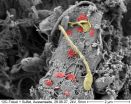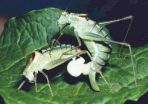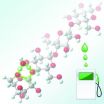(Press-News.org) PITTSBURGH, Dec. 13, 2012 – University of Pittsburgh Cancer Institute (UPCI) researchers have identified over 125 genetic components in a chemotherapy-resistant, brain tumor-derived cell line, which could offer new hope for drug treatment to destroy the cancer cells.
The results will be reported in the cover story of December's issue of the journal Molecular Cancer Research, to be published Dec. 18 and currently available online.
The potential drug targets were identified after testing more than 5,000 genes derived from glioblastoma multiforme, an aggressive brain tumor. The genes were evaluated for their role in responding to the chemotherapy drug temozolomide.
"The current standard of care for people with this type of cancer is to remove as much of the tumor as possible, and then treat with radiation and temozolomide," said lead author David Svilar, Ph.D., a student in the Medical Scientist Training Program at the University of Pittsburgh School of Medicine. "However, glioblastoma multiforme is highly resistant to this chemotherapy drug, so we need to find better treatments to improve the patient survival rate."
According to the National Cancer Institute, glioblastoma multiforme is the most common type of brain tumor in adults. It accounts for about 15 percent of all brain tumors, and typically occurs in people between the ages of 45 and 70 years.
Patients with glioblastoma multiforme usually survive less than 15 months after diagnosis, and there are no effective long-term treatments for the disease.
Temozolomide, also known by the brand name Temodar, works by modifying the cancer's DNA in a way that triggers cell death. It has been approved by the U.S. Food and Drug Administration for use in brain tumors and is in clinical trials for other cancers, such as melanoma and leukemia. It is well-tolerated in most patients.
"Unfortunately, some cancers - particularly glioblastoma multiforme – are able to repair the DNA damage done to the tumor by Temozolomide before the cancer cells are destroyed," said senior author Robert W. Sobol, Ph.D., a scientist at UPCI and an associate professor in the departments of Pharmacology & Chemical Biology and Human Genetics. "Clinical trials are underway to test drugs and chemotherapy dosing schedules to inhibit this repair, but none have proven effective to date."
Dr. Sobol and his colleagues identified multiple "druggable" targets that could make the cancer more sensitive to temozolomide, as well as the processes that allow the tumor to survive the onslaught of surgery, radiation and chemotherapy.
"Our hope is that drug companies will use our findings to develop adjuvant chemotherapy drugs that will vastly improve patient survival from this deadly cancer," said Dr. Sobol.
###
This research was supported by grants from the National Brain Tumor Society and National Institutes of Health (GM087798, CA148629 and ES019498) and a NYSTAR James Watson Award.
Co-authors include Madhu Dyavaiah, Ph.D., and Thomas J. Begley, Ph.D., both of the University at Albany; Ashley R. Brown, Jiang-bo Tang, Ph.D., Jianfeng Li, Ph.D., Peter McDonald, Ph.D., Tong Ying Shun, Andrea Braganza, Xiao-hong Wang, Salony Maniar, Claudette M. St Croix, Ph.D., John S. Lazo, Ph.D., and Ian F. Pollack, M.D., all of the University of Pittsburgh.
Contact: Jennifer Yates
Phone: 412-647-9966
E-mail: YatesJC@upmc.edu
About UPCI
As the only NCI-designated comprehensive cancer center in western Pennsylvania, UPCI is a recognized leader in providing innovative cancer prevention, detection, diagnosis, and treatment; bio-medical research; compassionate patient care and support; and community-based outreach services. UPCI investigators are world-renowned for their work in clinical and basic cancer research.
About the University of Pittsburgh School of Medicine
As one of the nation's leading academic centers for biomedical research, the University of Pittsburgh School of Medicine integrates advanced technology with basic science across a broad range of disciplines in a continuous quest to harness the power of new knowledge and improve the human condition. Driven mainly by the School of Medicine and its affiliates, Pitt has ranked among the top 10 recipients of funding from the National Institutes of Health since 1997. In rankings recently released by the National Science Foundation, Pitt ranked fifth among all American universities in total federal science and engineering research and development support.
Likewise, the School of Medicine is equally committed to advancing the quality and strength of its medical and graduate education programs, for which it is recognized as an innovative leader, and to training highly skilled, compassionate clinicians and creative scientists well-equipped to engage in world-class research. The School of Medicine is the academic partner of UPMC, which has collaborated with the University to raise the standard of medical excellence in Pittsburgh and to position health care as a driving force behind the region's economy. For more information about the School of Medicine, see www.medschool.pitt.edu. END
This press release is available in German.
Leipzig. Remains of dead bacteria have far greater meaning for soils than previously assumed. Around 40 per cent of the microbial biomass is converted to organic soil components, write researchers from the Helmholtz Centre for Environmental Research (UFZ), the Technische Universität Dresden (Technical University of Dresden) , the University of Stockholm, the Max-Planck-Institut für Entwicklungsbiologie (Max Planck Institute for Developmental Biology) and the Leibniz-Universität Hannover (Leibniz University Hannover) in the ...
This press release is available in German.
All a question of timing: When bushcrickets mate, the male attaches a sticky package, the so-called spermatophore, to the female's abdomen. Alongside the sperm themselves, this 'bridal present' consists of a protein-rich mass that the female eats after mating. It then takes several hours for the sperm to find their way into the female's reproductive tract. But, who decides when that will happen? A study by the Bielefeld biologists Professor Dr. Klaus Reinhold and Dr. Steven Ramm suggests that it is the male who determines the ...
Montréal, December 14, 2012 – Dr. Marie Kmita and her research team at the IRCM contributed to a multidisciplinary research project that identified the mechanism responsible for generating our fingers and toes, and revealed the importance of gene regulation in the transition of fins to limbs during evolution. Their scientific breakthrough is published today in the prestigious scientific journal Science.
By combining genetic studies with mathematical modeling, the scientists provided experimental evidence supporting a theoretical model for pattern formation known as the ...
New research from North Carolina State University provides molecular-level insights into how cellulose – the most common organic compound on Earth and the main structural component of plant cell walls – breaks down in wood to create "bio-oils" which can be refined into any number of useful products, including liquid transportation fuels to power a car or an airplane.
Using a supercomputer that can perform functions thousands of times faster than a standard desktop computer, NC State chemical and biomolecular engineer Dr. Phillip Westmoreland and doctoral student Vikram ...
Highlights
In a study of African Americans with kidney disease, levels of mineral metabolites rose over time; those with faster rates of kidney function decline had the greatest increases in metabolites.
Higher baseline levels of metabolites were linked with an increased risk for kidney failure or death independent of kidney function.
Disordered mineral metabolism is more severe in African Americans with chronic kidney disease, which might partially explain why their disease progresses more rapidly to kidney failure.
Washington, DC (December 13, 2012) — Abnormalities ...
Highlights
Blocking the receptor for endothelin lowers novel cardiovascular risk factors in patients with chronic kidney disease independent of blood pressure.
The findings suggest that blocking the receptor may provide heart-related benefits to these patients.
60 million people globally have chronic kidney disease.
Washington, DC (December 13, 2012) — Blocking the receptor for proteins that constrict blood vessels reduces markers of heart-related problems in patients with chronic kidney disease (CKD), according to a study appearing in an upcoming issue ...
A new study from the rainforests of Panama provides an unprecedented level of detail regarding the diversity and distribution of arthropod species from the soil to the forest canopy. Yves Basset, scientific coordinator of the CTFS Arthropod Initiative at the Smithsonian Tropical Research Institute, led an international team on Project IBISCA-Panama to sample, sort, catalogue, and finally estimate that a 6,000 hectare forest hosts a total of around 25,000 arthropod species – a figure vastly outnumbering that of better-studied organisms. The study will be published online ...
People over age 65 with high psychosocial distress face increased risk of stroke, according to new research in the American Heart Association journal Stroke.
Psychosocial distress is a broad concept that includes depression, stress, a negative outlook and dissatisfaction with life.
In their 10-year study, researchers followed 4,120 people in the Chicago Health and Aging Project for rates of death and stroke incidents. Due to some participants being involved in an HMO only 2,649 participants were analyzed for rates of incident stroke. Participants were 65 years and older ...
Washington, D.C. — When materials are stressed, they eventually change shape. Initially these changes are elastic, and reverse when the stress is relieved. When the material's strength is exceeded, the changes become permanent. This could result in the material breaking or shattering, but it could also re-shape the material, such as a hammer denting a piece of metal. Understanding this last group of changes is the focus of research from a team including Carnegie's Ho-kwang "Dave" Mao.
Their breakthrough research on the behavior nickel nanocrystals under intense pressure ...
The Government and police efforts to tackle financial crime – from business fraud to tax evasion – are hampered by a lack of accurate data about the nature and extent of offending, according to new research.
Most of the data available on financial crime is produced without a credible methodology, says Michael Levi, Professor of Criminology at Cardiff University, whose research was funded by the Economic and Social Research Council (ESRC).
"Typically, the information available on offending or threat is just a marketing hype," says Professor Levi. "It comes from business ...


